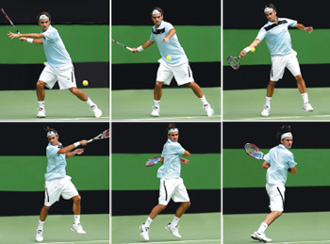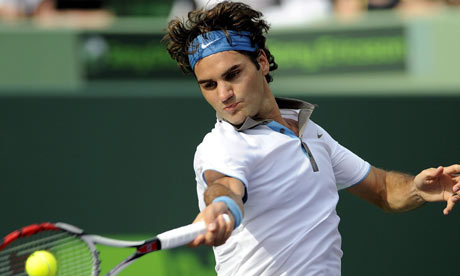That grip just prepares the racquet head at an uncommon angle; the rest of the success of the Federer forehand must be attributed to his impeccable technique.
Because the Federer forehand grip gets so much attention, let’s discuss it for a few moments. The grip is hotly debated by those who have analyzed it. Some claim it is an Eastern grip, others say an exaggerated Eastern, others call it something in between.
The best look at the Federer forehand grip seems to indicate that it is indeed an Eastern grip with a very slight twist. That is to say, he holds the racquet one bevel below the usual placement for a typical Eastern grip.
Learning the Roger Federer Forehand Grip


Despite what many might say about the Federer forehand grip, it is not simply an Eastern grip. To match the Federer forehand grip, you would have to place the top knuckle of your index finger on the right side of your racquet handle, not on the bevel above it. In other words, your knuckle would line up at 3 o’clock on the handle if you held your racquet out from your body and looked at it like a clock.
The normal Eastern grip would have the knuckle at 2 o’clock. Most players will find this grip quite extreme and uncomfortable. Undoubtedly, Federer practiced for many hours to hit a forehand with this unusual method.
Now to the actual forehand motion that makes Federer’s forehand so legendarily lethal. We will break down his motion into six steps, from initial preparation to follow-through, with accompanying comments on each stage of his motion:
Hitting Stances Used in Federer’s Forehand Grip


On a typical forehand, Federer stands in a ¾ open stance, which will guarantee excellent rotation of his corps for the shot to come. At the pro level, it is difficult to get into a closed position for full rotation of the body, there is simply not enough time. If you are playing someone who does not hit with much pace, you will have much more time than Federer to coil your body for maximum explosion through the ball.
If Federer and other pros took the time to close their stances and coil to the max, the ball would be in the hands of a ball boy standing behind them by the time they would have to hit it! In typically fine Federer form, his racquet head is pointed towards the back fence and the strings are facing downward, reflecting the famed Federer forehand grip. This is no problem for him, however, because the head will open up naturally as he begins his swing.
Federer’s Contact Point With the Forehand Grip


As Federer prepares to meet the ball, his forehand is usually noted for having an extreme acceleration in the last 18 inches before contact is made.
This is due in large part to the position of his wrist, which is bent almost entirely back from the racquet, ensuring another whip-like component that will add punch to the shot. That position of the wrist will also give Federer the option to hit his inside-out forehand if he so chooses.
Use of the Wrist in the Federer Forehand Stroke
In some photos, Federer’s racquet is at a 90-degree angle from his hand and the ball, quite a contrast to lesser-skilled players who sweep through the forehand as if holding a broomstick. Adding this extra wrist snap to your stroke will take lots of practice, but it is one of the main reasons why the pros hit the ball much harder than those of us in the amateur ranks.
As Federer’s wrist uncocks in response to the rest of his body rotating towards the ball and opening up (not hitting inside-out), he meets the ball at about a mid-thigh level. In order to place maximum topspin on the ball, the racquet face is vertical, ensuring a maximum brush of the strings against the ball.
Contact Height – An element of Roger Federer’s Forehand Grip?


When Federer takes the ball in different parts of the court and in response to different bounces, he might meet the ball above his waist, yet he maintains his almost-perfect form. It should also be mentioned that in any photo study of the Federer forehand, perhaps the body part that should be most closely examined is his head.
In photo after photo after photo, his head remains still, his eyes laser focused on the ball.
Not even the man who some people call the greatest to ever play the game can take his eye off the ball and hit a solid forehand. That’s important to remember for the average club player: head still, eye on the ball.
Federer’s Head Position On His Forehand
Just after the point of contact, Federer’s head is still stationary and his eyes peer at the point where his racquet met the ball for a split second. In some shots, Federer’s racquet has already risen about a foot, indicating that he has put a wicked topspin on the ball. This part of the Federer forehand represents another part of the motion that separates the pros from the average Joes. Many club players have little or no follow-through, which limits the power of their stroke tremendously and hurts their promising form. Practice your follow-through constantly to ensure full power behind your shot.
Wrist Position with the Federer Forehand Grip
The position of Federer’s wrist just after contact will tell us all we need to know about where Federer has hit the ball. Famous for his inside-out forehand, if Federer’s wrist remains cocked, you can bet your bottom dollar that he has successfully struck another inside-out forehand to his opponent’s backhand side. If the wrist is aligned with the racquet, then Federer has whipped it forward to match his excellent torso rotation and zinged another forehand that draws paint and left his opponent dumbfounded.
Roger Federer forehand follow through


As Federer continues his follow-through, he either has transferred his weight completely forward if his feet got into position in enough time, or he is hitting off his back foot in reaction to the type of heavy topspin that his mortal enemy Rafael Nadal offers.
If hitting off the back foot, Federer exaggerates the whip upward of his racquet to compensate for his lack of power by hitting off the back foot with extra topspin, a good tip for all players to note.
If his body is properly aligned and he has transferred all of his power from back foot to front foot, he has a much more normal follow-through with the racquet at about shoulder height shortly after striking the ball.
The unique Federer forehand starts with the famed Federer forehand grip, which is one small step beyond the standard Eastern grip.
If you want to completely mimic Federer’s forehand, you will have to hold the racquet in the same way. Another element of the Federer forehand that will be difficult to adopt is his wrist cock, which gives him added power and an easier ability to hit the inside-out forehand that has doomed many an opponent.
Learning the Roger Federer Forehand Grip and Technique
So, once you are holding the racquet in a way that feels right to you, then you can imitate the other elements of the Federer forehand that you can actually copy: head still, eyes on the ball, fairly open stance, racquet strings brushing the ball upward for topspin, full follow-through.
Federer arrived at his place in the tennis pantheon by spending hours and hours perfecting a forehand that he could hit in two directions starting from a near-impossible angle. It is probably too late for you to do the same, but with enough practice you can perhaps add a wrist-whip and more topspin so that you can approximate the fearsome weapon known as the Federer forehand. With enough practice, you can master the inside-out forehand as well and further confound your opponents.
Learn to Hit a Forehand Like Roger Federer
If you want to jumpstart your forehand and play like the PROS, check out my 70+ page Tennis Ebook that will immediately show you how you can take your forehand to the next level.
The Modern Forehand Domination Ebook is guaranteed to improve your tennis technique, and increase power, topspin and accuracy of your tennis forehand!
Modern Tennis Forehand Ebook
Learn How to Hit a Forehand Like Federer, Nadal and Djokovic

